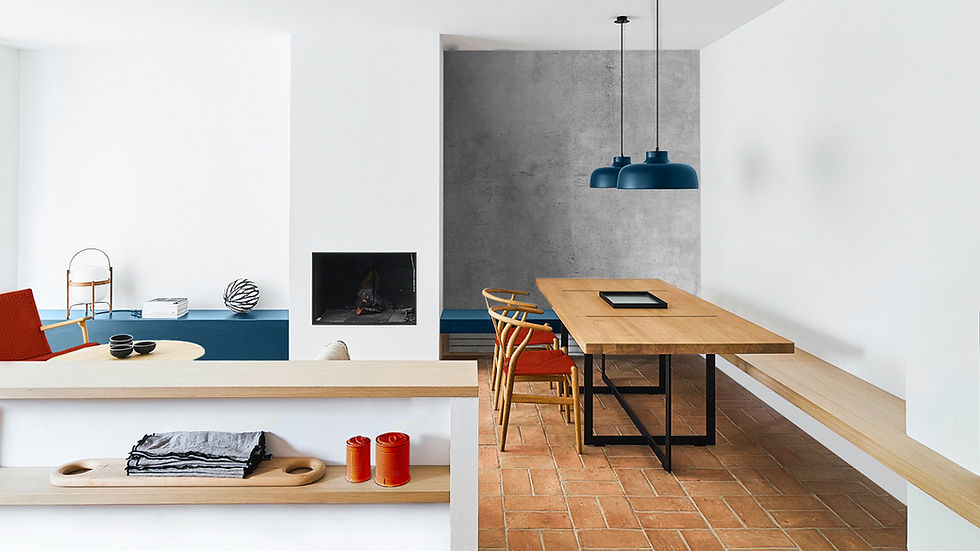Creating a Functional Home Office: Design Tips for Productivity
- Design touch24

- Jun 16, 2023
- 3 min read

Introduction:
As remote work and flexible schedules become increasingly common, having a functional and productive home office is essential. A well-designed workspace not only enhances focus and productivity but also contributes to overall well-being. In this article, we will explore practical design tips and strategies to create a functional home office that maximizes productivity and inspires success. From ergonomic furniture choices to effective organization solutions, let's delve into the key elements that will transform your home office into a productive haven.
Choose the Right Location: Selecting the optimal location for your home office is crucial. Look for a quiet area with minimal distractions, ideally away from high-traffic areas. Natural light is also essential, as it improves mood and boosts productivity. Position your desk near a window to take advantage of natural daylight and consider adding adjustable window treatments to control glare.
Invest in Ergonomic Furniture: Ergonomics plays a significant role in creating a comfortable and healthy workspace. Invest in an ergonomic desk and chair that promote proper posture and provide adequate support for your back, neck, and wrists. Adjustable features such as height, tilt, and lumbar support are essential for customizing your setup to suit your individual needs.
Prioritize Organization: A cluttered and disorganized workspace can hinder productivity and increase stress levels. Implement effective organizational systems to keep your home office tidy and efficient. Use storage solutions like shelves, cabinets, and drawers to keep supplies, documents, and equipment neatly organized and easily accessible. Consider utilizing digital storage and labeling systems to minimize physical clutter.
Enhance Lighting: Proper lighting is essential for a functional and productive home office. In addition to natural light, incorporate task lighting to illuminate your workspace adequately. Opt for adjustable desk lamps or overhead lighting fixtures that offer both ambient and focused lighting options. A well-lit environment reduces eye strain and promotes alertness and concentration.
Ergonomic Technology Setup: Beyond furniture, consider the ergonomics of your technology setup. Position your computer monitor at eye level to reduce strain on your neck and eyes. Invest in an ergonomic keyboard and mouse that support proper hand and wrist positioning. Use cable management solutions to keep cords organized and minimize tripping hazards.
Design for Inspiration: Aesthetics play a significant role in creating an inspiring home office environment. Surround yourself with elements that motivate and inspire you. Choose colors that promote focus and creativity, such as blues and greens. Incorporate artwork, motivational quotes, or a vision board that reflects your goals and aspirations. Personalize your space to create an environment that energizes and uplifts your spirits.
Create Functional Zones: If your home office serves multiple purposes, create distinct zones within the space. Separate areas for work, storage, and relaxation can help maintain focus and productivity. Use room dividers, bookshelves, or strategic furniture placement to delineate each zone effectively.
Soundproofing Solutions: Noise distractions can significantly impact productivity, especially in a home office environment. Consider soundproofing solutions like acoustic panels, soundproof curtains, or noise-canceling headphones to minimize external disturbances and create a quieter atmosphere conducive to concentration.
Incorporate Greenery: Introducing plants into your home office brings numerous benefits. Not only do plants enhance the visual appeal of your space, but they also improve air quality and create a sense of calm. Choose low-maintenance indoor plants that thrive in office environments and place them strategically throughout your workspace.
Personalize Your Space: Finally, infuse your personality into your home office. Display meaningful items, photographs, or artwork that bring joy and inspiration. Surround yourself with things that reflect your passions and interests, creating a space that truly feels like your own.
Conclusion:
Designing a functional home office is essential for maximizing productivity and overall well-being in today's remote work landscape. By implementing the practical design tips discussed in this article, from ergonomic furniture choices to effective organization solutions and personalized touches, you can create a home office that supports your work goals and inspires success. Remember, a well-designed and functional workspace is the key to unlocking your full potential and achieving productivity in the comfort of your own home.




Comments